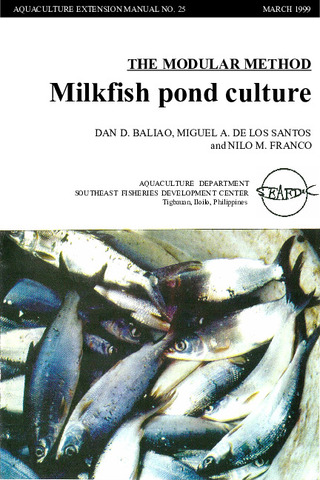The effect of stunting on growth, survival, and net production of milkfish (Chanos chanos Forsskal)
- Global styles
- MLA
- Vancouver
- Elsevier - Harvard
- APA
- Help

View/
Date
1988Author
Page views
4,250ASFA keyword
AGROVOC keyword
Taxonomic term
Metadata
Show full item record
Share
Abstract
The seasonal abundance of milkfish fry in the Philippines has led to the practice of buying a sufficient supply during the peak season to compensate for the shortage during slack periods. Fry that are not immediately grown out are crowded and stunted in transition ponds until they are transferred to rearing ponds. Milkfish farmers believe that stunted fingerlings grow faster than newly grown ones and therefore yield extra croppings. To assess the efficiency of production schemes, stunted and non-stunted milkfish fingerlings were cultured in twelve 144-m2 ponds for a 3-month period. The treatments employed were: Treatment I, 2-month-old fingerlings; Treatment II, 3-month-old fingerlings; and Treatment III, 6-month-old fingerlings, with the initial weights of 3.3 g, 7.8 g, and 43.1 g, respectively. Survival, netproduction, cumulative and monthly weight gains did not differ significantly (P > 0.05) among the three treatments. The results indicate that stunting did not illicit a significant increase, nor did it adversely affect the growth, survival, and netproduction of milkfish in a straight culture system. Stunting can therefore be practised by farmers to provide an adequate supply of fingerlings for year-round operation.
Description
Contribution No. 232 of the SEAFDEC Aquaculture Department.
Suggested Citation
Bombeo-Tuburan, I. (1988). The effect of stunting on growth, survival, and net production of milkfish (Chanos chanos Forsskal). Aquaculture , 75(1–2), 97-103. https://doi.org/10.1016/0044-8486(88)90024-5
Type
ArticleISSN
0044-8486Collections
- Journal Articles [1258]
Related items
Showing items related by title, author, creator and subject.
-
Series: Aquaculture extension manual; No. 25
The modular method: Milkfish pond culture
Baliao, Dan D.; de los Santos, Miguel A.; Franco, Nilo M. (Aquaculture Department, Southeast Asian Fisheries Development Center, 1999)The modular method of milkfish culture (Chanos chanos) described in the manual is an improvement over the traditional extensive method. The manual is intended for the use of fish farmers and aquaculturists, extensionists, ... -
Evaluation of organic and inorganic fertilizers in brackishwater milkfish ponds
Bombeo-Tuburan, Isidra; Agbayani, Renato F.; Subosa, Precilla F. (Elsevier, 1989)The study was conducted in twelve 144-m2 ponds to evaluate the effect of different organic and inorganic fertilizers on the growth, survival, gross production, and profitability of marketable milkfish. The ... -
Milkfish breeding and hatchery technology at SEAFDEC/AQD
Unknown author (Aquaculture Department, Southeast Asian Fisheries Development Center, 1999)Describes the techniques already adopted by the private sector: broodstock management, broodstock diet, commercial fry production, live transport, and larval diet. A list of AQD research publications on milkfish is included.





